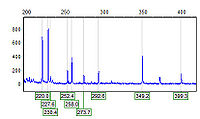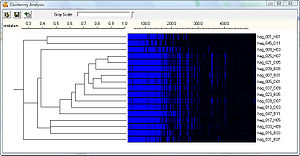
Amplified fragment length polymorphism
Encyclopedia

Polymerase chain reaction
The polymerase chain reaction is a scientific technique in molecular biology to amplify a single or a few copies of a piece of DNA across several orders of magnitude, generating thousands to millions of copies of a particular DNA sequence....
tool used in genetics
Genetics
Genetics , a discipline of biology, is the science of genes, heredity, and variation in living organisms....
research, DNA fingerprinting, and in the practice of genetic engineering
Genetic engineering
Genetic engineering, also called genetic modification, is the direct human manipulation of an organism's genome using modern DNA technology. It involves the introduction of foreign DNA or synthetic genes into the organism of interest...
. Developed in the early 1990s by Keygene, AFLP uses restriction enzymes to digest genomic DNA
Genome
In modern molecular biology and genetics, the genome is the entirety of an organism's hereditary information. It is encoded either in DNA or, for many types of virus, in RNA. The genome includes both the genes and the non-coding sequences of the DNA/RNA....
, followed by ligation
Ligation
Ligation may refer to:* In molecular biology, the covalent linking of two ends of DNA molecules using DNA ligase* In medicine, the making of a ligature * Chemical ligation, the production of peptides from amino acids...
of adaptors to the sticky ends of the restriction fragment
Restriction fragment
A restriction fragment is a DNA fragment resulting from the cutting of a DNA strand by a restriction enzyme , a process called restriction. Each restriction enzyme is highly specific, recognising a particular short DNA sequence, or restriction site, and cutting both DNA strands at specific points...
s. A subset of the restriction fragments is then selected to be amplified. This selection is achieved by using primers complementary to the adaptor sequence, the restriction site sequence and a few nucleotides inside the restriction site fragments (as described in detail below). The amplified fragments are visualized on denaturing polyacrylamide
Polyacrylamide
Polyacrylamide is a polymer formed from acrylamide subunits. It can be synthesized as a simple linear-chain structure or cross-linked, typically using N,N-methylenebisacrylamide. Polyacrylamide is not toxic...
gels
Electrophoresis
Electrophoresis, also called cataphoresis, is the motion of dispersed particles relative to a fluid under the influence of a spatially uniform electric field. This electrokinetic phenomenon was observed for the first time in 1807 by Reuss , who noticed that the application of a constant electric...
either through autoradiography or fluorescence
Fluorescence
Fluorescence is the emission of light by a substance that has absorbed light or other electromagnetic radiation of a different wavelength. It is a form of luminescence. In most cases, emitted light has a longer wavelength, and therefore lower energy, than the absorbed radiation...
methodologies.
AFLP-PCR is a highly sensitive method for detecting polymorphism
Polymorphism (biology)
Polymorphism in biology occurs when two or more clearly different phenotypes exist in the same population of a species — in other words, the occurrence of more than one form or morph...
s in DNA
DNA
Deoxyribonucleic acid is a nucleic acid that contains the genetic instructions used in the development and functioning of all known living organisms . The DNA segments that carry this genetic information are called genes, but other DNA sequences have structural purposes, or are involved in...
. The technique was originally described by Vos and Zabeau in 1993. In detail, the procedure of this technique is divided into three steps: http://www.keygene.com/keygene/techs-apps/FLASH3.php
- Digestion of total cellular DNA with one or more restriction enzymeRestriction enzymeA Restriction Enzyme is an enzyme that cuts double-stranded DNA at specific recognition nucleotide sequences known as restriction sites. Such enzymes, found in bacteria and archaea, are thought to have evolved to provide a defense mechanism against invading viruses...
s and ligation of restriction half-site specific adaptors to all restriction fragments. - Selective amplification of some of these fragments with two PCR primers that have corresponding adaptor and restriction site specific sequences.
- Electrophoretic separation of amplicons on a gel matrix, followed by visualisation of the band pattern.
A variation on AFLP is cDNA-AFLP, which is used to quantify differences in gene expression levels.
Another variation on AFLP is TE Display, used to detect transposable element mobility.
Applications

Quantitative trait locus
Quantitative traits refer to phenotypes that vary in degree and can be attributed to polygenic effects, i.e., product of two or more genes, and their environment. Quantitative trait loci are stretches of DNA containing or linked to the genes that underlie a quantitative trait...
(QTL) analysis.
There are many advantages to AFLP when compared to other marker technologies including randomly amplified polymorphic DNA (RAPD
RAPD
RAPD stands for random amplification of polymorphic DNA. It is a type of PCR reaction, but the segments of DNA that are amplified are random. The scientist performing RAPD creates several arbitrary, short primers , then proceeds with the PCR using a large template of genomic DNA, hoping that...
), restriction fragment length polymorphism
Restriction fragment length polymorphism
In molecular biology, restriction fragment length polymorphism, or RFLP , is a technique that exploits variations in homologous DNA sequences. It refers to a difference between samples of homologous DNA molecules that come from differing locations of restriction enzyme sites, and to a related...
(RFLP), and microsatellites. AFLP not only has higher reproducibility, resolution, and sensitivity at the whole genome level compared to other techniques, but it also has the capability to amplify between 50 and 100 fragments at one time. In addition, no prior sequence information is needed for amplification (Meudt & Clarke 2007). As a result, AFLP has become extremely beneficial in the study of taxa including bacteria, fungi, and plants, where much is still unknown about the genomic makeup of various organisms.
The AFLP technology is covered by patents and patent applications of Keygene N.V.
AFLP is a registered trademark of Keygene N.V.
See also
External links
Software for analyzing AFLP data- KeyGene Quantar Suite Versatile marker scoring software
- SoftGenetics GeneMarker fragment analysis software
Freeware for analyzing AFLP data
- SourceForge Genographer Free software for manual scoring (Java application)
- SourceForge RawGeno Free automated scoring (R CRAN environment, including a user-friendly GUI)
Online programs for simulation of AFLP-PCR
- ALFIE - BProkaryotes or uploaded sequences
- In silico AFLP-PCR for prokaryotes, some eukaryotes or uploaded sequences
- Enzymes for AFLP New England Biolabs

